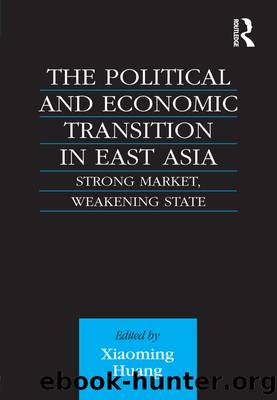The Political and Economic Transition in East Asia by Xiaoming Huang

Author:Xiaoming Huang [Huang, Xiaoming]
Language: eng
Format: epub
Tags: Social Science, Ethnic Studies, General, Regional Studies
ISBN: 9781136114502
Google: rYEnAAAAQBAJ
Publisher: Routledge
Published: 2013-09-05T05:50:06+00:00
A Democratically Contested State
The period from the end of the 1940s (when the Kuomintang, or KMT, government moved to Taiwan) to 1986 (when the principal opposition party, the Democratic Progressive Party, or DPP, was founded and subsequently President Chiang Ching-kuo, towards the end of his life, ordered the lift of Martial Law banning free press and political parties) is regarded as the authoritarian era in the recent history of Taiwan. The following decade from 1986 to 1996, when âfounding electionsâ had been successfully held and for the first time the President was directly elected through popular vote, is generally considered as the period of democratic transition.
Thus, while some may see an earlier âjuncture,â for example, in 1977 when the ruling KTM suffered the first major setback in local elections and its local factions allied themselves with opposition forces in a rebellion against the KTM (Chen 1995: 268), many, including this author, see 1986 as the âstarting pointâ of the process of democratisation (Tien and Cheng 1997:1). For Tien and Chen, 1986 as the cutting-off point involves a sophisticated theory of democratisation. For this author, the year separated two very different historical periods in terms of the distribution of political authority. The authoritarian era featured the predominance of the party-state with political power concentrating in the hands of the state, the KMT, and its two successive chairmen, Chiang Kai-shek and Chiang Ching-kuo. The democratisation, in essence, was a redistribution of the political power. Instead of the state being the sole power holder, political authority was relocated to the citizenry, exercised on their behalf by representative institutions: branches of national government, competitive political parties and local government.
The decade-long democratic power redistribution can be seen in three areas. The first was the establishment of a competitive party system. The rapid growth of the DPP and reorientation or revitalisation of the KMT led to the emergence of a competitive party system with the dominance of the two major political parties. Second, a series of steps in constitutional reform streamlined relations among branches of the national government distorted under the authoritarian party-state of the Cold War. The democratic power redistribution also took place intensively between the local and central government. As will be demonstrated in this study, the democratic process not only restructured the authority distribution, and provided legitimacy for the new political order, but also turned the state into an institution whose actions are accountable to the public, constrained by legal procedures, and subject to credible challenges from contending political forces and interest groups.
Download
This site does not store any files on its server. We only index and link to content provided by other sites. Please contact the content providers to delete copyright contents if any and email us, we'll remove relevant links or contents immediately.
International Integration of the Brazilian Economy by Elias C. Grivoyannis(86537)
The Radium Girls by Kate Moore(11867)
Turbulence by E. J. Noyes(7895)
Nudge - Improving Decisions about Health, Wealth, and Happiness by Thaler Sunstein(7461)
The Black Swan by Nassim Nicholas Taleb(6948)
Rich Dad Poor Dad by Robert T. Kiyosaki(6319)
Pioneering Portfolio Management by David F. Swensen(6170)
Man-made Catastrophes and Risk Information Concealment by Dmitry Chernov & Didier Sornette(5878)
Zero to One by Peter Thiel(5638)
Secrecy World by Jake Bernstein(4594)
Millionaire: The Philanderer, Gambler, and Duelist Who Invented Modern Finance by Janet Gleeson(4300)
Skin in the Game by Nassim Nicholas Taleb(4123)
The Age of Surveillance Capitalism by Shoshana Zuboff(4118)
The Money Culture by Michael Lewis(4027)
Bullshit Jobs by David Graeber(3995)
Skin in the Game: Hidden Asymmetries in Daily Life by Nassim Nicholas Taleb(3868)
The Dhandho Investor by Mohnish Pabrai(3637)
The Wisdom of Finance by Mihir Desai(3607)
Blockchain Basics by Daniel Drescher(3430)
